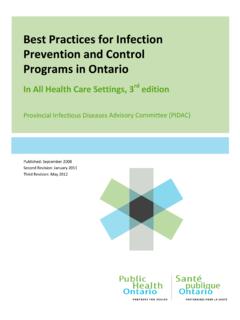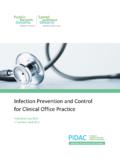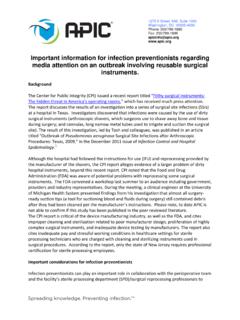Transcription of Overview of the IHR Core capacities - CAPSCA
1 IHR core capacities Overview and Monitoring Presented by Dr. Samir Refaey Director of Epidemiology and Surveillance Unit Ministry of Health and Population, Egypt Cooperative Agreement for Prevention of Spread of Communicable Diseases through Air Travel ( CAPSCA ) 11 15 December 2011 Cairo, Egypt. 2 Outline What are the IHR? IHR Agenda for National core capacities core Capacity Requirements Monitoring of IHR core Capacity Development Tools for monitoring IHR Implementation Outputs of Monitoring IHR core capacity Conclusion What are the IHR? Ensuring maximum public health security while minimizing interference with international transport and trade Came into force on 15 June 2007 Legally binding for WHO and the world s countries that have agreed to play by the same rules to secure international health. An agreement among 193 countries Facilitated by WHO Secretariat Highlights of IHR (2005) broader scope (all threats) Operational: National and WHO IHR Focal Point & competent authorities , notification, verification & assessment Health Emergencies of International Concern (PHEIC) measures from WHO in public health emergencies of international concern obligation: National core capacity requirements IHR Agenda for National core capacities Strengthening 15 June 2007 2009 2012 2014 2016 May 2005: Adoption of IHR(2005) Possible extension of 2 + 2 years Monitoring IHR Implementation core Capacity Requirements 8 core capacities Legislation and Policy Coordination Surveillance Response Preparedness Risk Communications Human Resources Laboratory 3 levels National Intermediate Peripheral/Community Potential Hazards Infectious Zoonosis Food safety Chemical Radio nuclear Events at Points of Entry core Capacity 1.
2 Legislation, Policy and Finance National Legislation should allow Compliance with IHR IHR NFP Designation and Operations Detection, reporting, verification and control of events Implementation of IHR Documents Ship and Sanitation certificate Maritime Declaration of health, International Certificate of vaccination and prophylaxis Health part of aircraft general Declaration Definition of implementing structures, organization, roles and responsibility Capacity 2: Coordination Coordination Within Sectors: all levels of the HC System Across sectors: Chemical, Food safety, Radio Leadership Advocacy "..a national public health emergency response plan, including the creation of multidisciplinary/multisectoral teams to respond to events that may constitute a public health emergency." Implementing in Synergy Co-ordination: Working in Partnership Partners (Technical and Donors) MOH Other Sectors core Capacity 3: Surveillance Types of surveillance: Event Based Surveillance Indicator Based Surveillance (standard/routine surveillance) core Surveillance functions Event detection and confirmation Risk Assessment Reporting/notification Data Management and analysis Feedback and supervision Surveillance Structure for risk assessment, risk monitoring, investigation and control core Capacity 4: Response Rapid Response Capacity Public Health Emergency Response mechanisms (management procedures, operational communication links, command centres etc.)
3 Rapid Response Teams (RRT) at national and sub-national levels Case Management procedures for various PH hazards Infection Prevention and Control (IPC) at health facilities of all levels Disinfection, decontamination and vector control capabilities for all hazards core Capacity 5: Preparedness Emergency Preparedness Programme Multi-sectoral Overarching programme for the development of capacities to manage the risk of emergencies Emergency Preparedness and Response Plans All Hazards Test plans Risk and Resource mapping Capacity 5: Preparedness Stockpiling All hazard (country priorities) Stock rotation National supply and distribution plan Capacity to support sub-national level Guidelines, SoPs Training Resources, logistics etc. core Capacity 6: Risk Communications Communication Coordination Release of public information during an emergency Listening to those affected and involved Communication evaluation Emergency Communication Plan core Capacity 7: Human Resources Capacity Policy, collaboration and coordination framework between training institutions Human resource capacity mapping: Availability Distribution Competencies Continuous training in relevant areas Field epidemiology training core Capacity 8: Laboratory Capacity Laboratory Services Sample collection and transport Biosafety and Biosecurity Quality Assurance Programme Laboratory based surveillance.
4 Data Management and reporting systems Points of Entry Legislation and Policy Coordination Technical guidance and operational procedures for PoE Surveillance and Response General Obligations required at PoE Hazards Food safety and Product safety Zoonosis Chemical Safety Radio-nuclear Safety Monitoring of IHR core Capacity Development Monitoring IHR core Capacity Development: Background DG of WHO expected to report to the WHA on progress made in implementation of the IHR. Country's report on progress WHO's report on progress towards implementation Need for countries to monitor progress in core capacity development and address gaps Monitoring of development of 8 core capacities , across IHR relevant hazards and PoE Indicators Indicators developed to measure progress towards IHR core capacities implementation in a standardized way Two parts: One set for States Parties Report (20 indicators) An additional set for more comprehensive monitoring (8 more indicators)
5 Analysis of data by Country and WHO In-country dissemination to different stakeholders, partners and level as deemed necessary by country Checklist CC7 Human Resource Capacity[1] Component of core Capacity Country level Indicator Current Status of Implementation of core capacities <1 1 2 3 Human Resource Capacity Human resources available to meet IHR core Capacity development requirements No training plans for workforce development Government instruments/policy to release staff for in-service and other form of training Comprehensive workforce development plans approved with funding for implementation Targets being achieved for meeting workforce numbers and skills consistent with targets set in development plan Specific program exists to generate other needed human resource to meet IHR requirements nationally[4] Evaluation reports of adequacy of human resource capacity during responses published and publicly available core Capacity Component Indicator Attributes Maturation International Health Regulations (2005) IHR MONITORING FRAMEWORK: Checklist and Indicators for Monitoring Progress in the Development of IHR core capacities in States Parties February 2011 Tools for monitoring IHR Implementation Checklist of Indicators States Parties Questionnaire Online IHR Monitoring Tool To access the IHRMT online tool please go to the IHR Portal at How to Access the tool?
6 At: Accessing the National Capacity Monitoring Tool Choosing which Capacity to answer National Capacity Monitoring online Tool Filling in your answers Outputs of Monitoring IHR core capacity development Various reports Detailed NFP Reports WHA Reports EB Reports Others ex. Review Committee Provide country profiles that enable national stakeholders to: asses progress made identify capacity gaps and prioritize capacity building Provide an Overview of progress of implementation of IHR at regional, and global levels Country profiles, regional and global overviews of the status of IHR implementation with respect to the 2012 deadline. Achievement of core capacities in EMRO 2010-2011 (for countries reporting in both years) 7073717454764371527254384275767875586553 695576644554 LegislationCoordinationSurveillanceRespo nsePreparednessRisk CommunicationHuman ResourcesLaboratoryPo EZoonosisFood Saf etyChemicalRadiologicalEMR20112010 Capacity: Score as % 1 2 3 4 5 6 7 8 9 10 11 12 13 Egypt 75 66 90 100 87 85 75 80 100 88 75 66 91 Achievement of core capacities in Egypt -2011 Conclusion and recommendations Egypt is more or less on track for IHR implementation There is a need for more advocacy meetings targeting all relevant stakeholders and decision makers in other sectors to facilitate inter-sectoral communication and coordination Working at the cabinet level to set up the legislative and the financial issues More investment in building the capacities of other stakeholders International Health Regulations (2005) IHR core CAPACITY MONITORING FRAMEWORK.
7 QUESTIONNAIRE FOR MONITORINGPROGRESS IN THE IMPLEMENTATION OF IHR core capacities IN STATES PARTIES 2011 Questionnaire Page 1 of 21 STATE PARTY MONITORING QUESTIONNAIRE FOR core capacities RELATING TO THE INTERNATIONAL HEALTH REGULATIONS (2005) Date: / / (dd/mm/yyyy) The IHR Secretariat is required to provide an annual report to the World Health Assembly detailing WHO and States Parties progress on IHR implementation. In order to assist the States Parties in their responsibility to report to the Assembly, the IHR Secretariat has developed a data collection tool which will enable each State Party to provide standardized information about progress of its core capacity development in implementation of IHR (2005) (IHR). The completed data collection tool can be submitted to via email or by fax to +41227914667 or in hard copy to IHR Monitoring (IHR/NCM) 20, avenue Appia, 1211 Geneva 27 Switzerland.
8 The submission of this questionnaire will allow the compilation of a consistent report to the Assembly. However, the use of this format by States Parties is entirely voluntary. All questions should be completed. Respondent identification State Party Name and title of contact officer for this report Telephone number E-mail Enquiries relating to the questionnaire should be directed to the IHR Monitoring Team at After completing the questionnaire IHR-NFP should please indicate top three priority areas for strengthening: Page 2 of 21 INSTRUCTIONS FOR COMPLETING QUESTIONNAIRE This data collection tool is designed primarily for use by National IHR Focal Points (NFPs) in collaboration with public health professionals, managers and other sectors and stakeholders responsible for implementing the IHR. Completion of the questionnaire may require input from professionals and representatives from other sectors such as animal health, food and water safety, environmental health, radiological, nuclear, and chemical disciplines.
9 Data collection should be carried out by the IHR NFPs in consultation with these experts. The data collection process can be accomplished through a workshop, with the questionnaires distributed to the relevant expert groups beforehand, or through other means as appropriate in a specific country context. WHO can provide technical assistance upon request by the States Parties. The completed data collection tool should be properly attested by the IHR NFP and submitted to with copies to the WHO Regional Office and where available, to the WHO Country Office. The questionnaire is divided into thirteen sections, one for each of the eight core capacities , PoE and four hazards. Individual questions are grouped by Components and Indicators in the questionnaires. The individual questions are self-explanatory and any additional comments or contributions you may wish to make can be accommodated at the end of each section, in the comment box.
10 Additional pages may also be added if required. For each question, mark only one appropriate value (Yes, No, or Not Known) or the appropriate percentages. For statistical purposes, the Not Known value will be computed as a No value. Questions may cover multiple aspects of implementation, and it is important to note that when answering yes to a question, it should mean a yes to all such aspects. In order to answer "yes" to a given question both the presence ( function is available) and quality of the function ( the content is directly relevant to the indicator, component and the IHR) should be considered, and both must be present to qualify for a yes answer. Partly fulfilled functions can be further commented in the comments box, but should be answered as "no". "No" to a question therefore means all or part of the function is not present. If possible, please provide a link to, or a hard copy of: documentation of laws, policies, designated PoE and their competent authorities, authorized ports (with ISO, LOCODE, SSCC, SSCEC and Extension), website, publications, reports etc.



